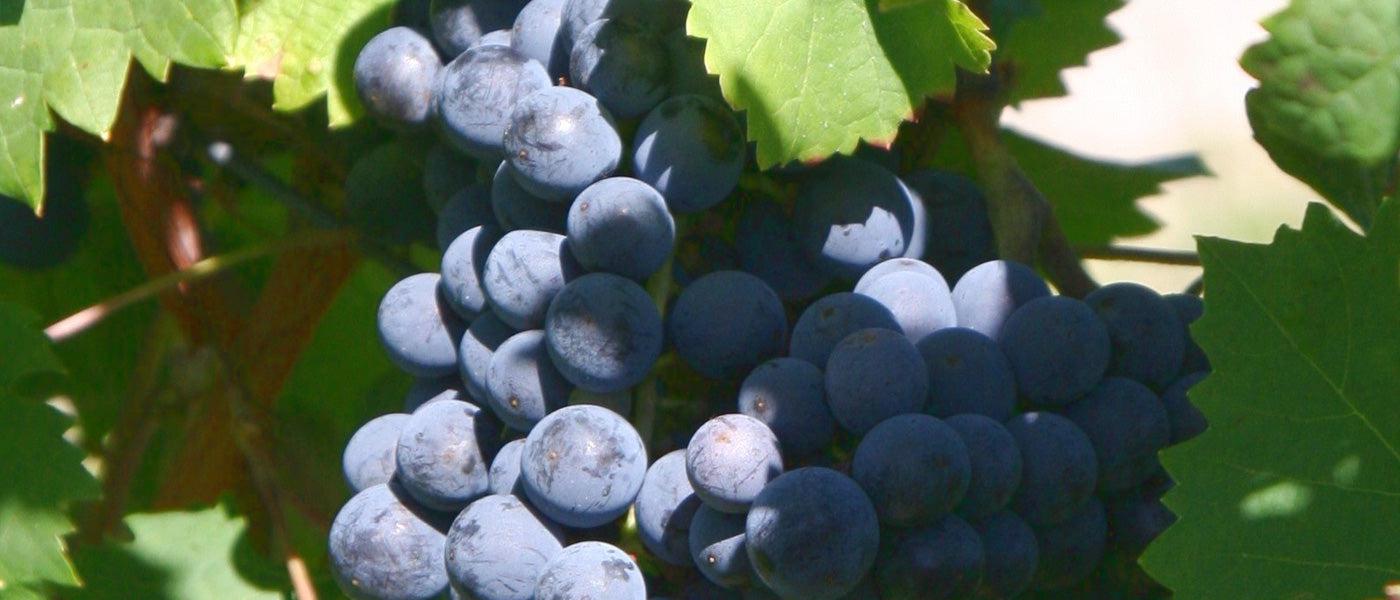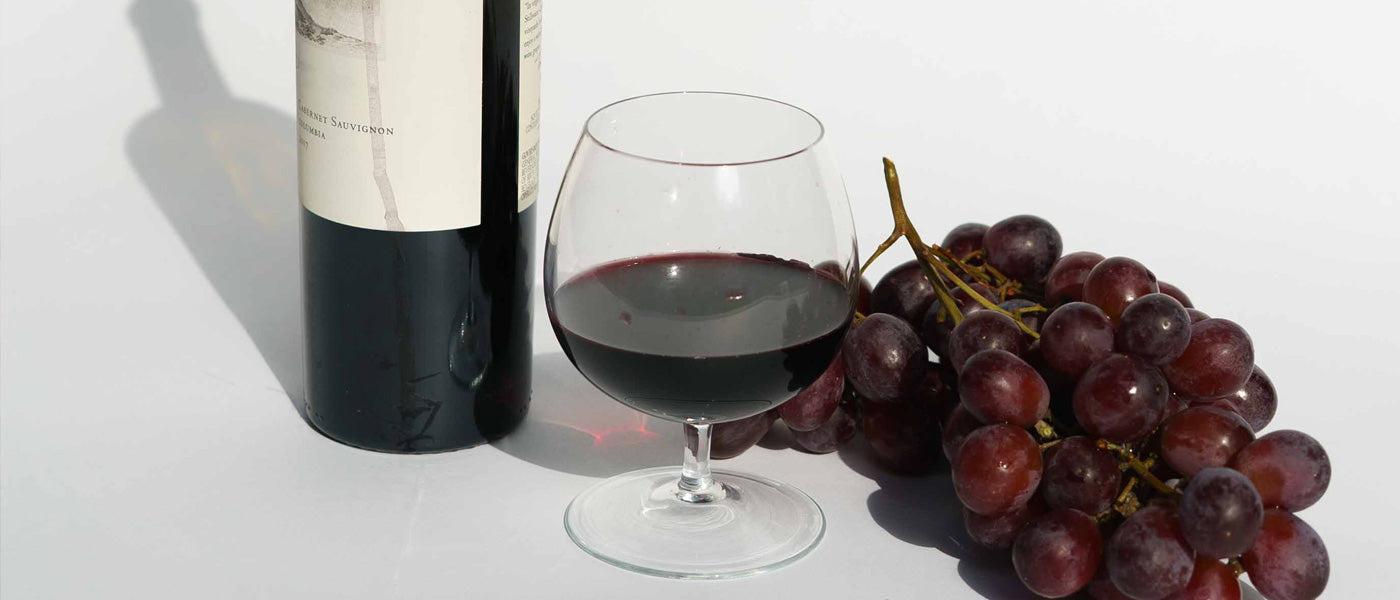Cabernet Sauvignon is a dry red wine with high tannins and low acidity, despite it being made using sweet grapes.
It is similar in style to other dry reds such as Merlot and Malbec but has a fullness that appeals to those who prefer full-bodied wines.
With an average ABV of 13.5%, Cabernet Sauvignon is not overly high in alcohol, and thanks to its dryness, it is an incredibly versatile wine.

Cabernet Sauvignon Tasting Notes
Cabernet Sauvignon wines vary from country to country, but most explode with fruity flavours.
You can expect plum, black cherry, blackberry, and blackcurrants in every sip.
Its high tannin content brings out cedar and tobacco aromas and concentrated milk chocolate and vanilla flavours.
Other tasting notes include:
- Black pepper
- Cinnamon
- Anise
- Violet
- and Eucalyptus
Cabernet Sauvignon is a dark red wine, rich in colour, flavour, and bouquet.
Those aged in oak barrels have a slightly woody aftertaste but remain smooth and easy to drink.
How To Chill Cabernet Sauvignon
Cabernet Sauvignon wines are best when stored and served below room temperature.
Store and serve Cab Sav wines anywhere between 12-18°C, depending on your preference.
If you need one in a hurry, you can chill it in your fridge for an hour before serving, but the temperature is everything when enjoying this red wine.
We recommend you purchase a wine fridge to store your wine for long term storage.
Do not store them in the fridge for a long time, because if they are too cold, they can become dull and flat.
But in contrast, don't serve them too warm either, as they’ll taste overpowering and alcoholic.

Cabernet Sauvignon Red Wine Characteristics
Cabernet Sauvignon wines are beautifully balanced and deliver the perfect combination of acidity, tannins, sweetness, alcohol levels, and body.
Here are some interesting characteristics:
Alcohol Levels
These wines typically have an alcohol-by-volume rating of 13.5 to 15% ABV.
Sweetness Levels
Cab Sav is a dry red wine with low residual sugar levels. It’s neither sweet nor medium and best suited to those with a dry palette.
Acidity Levels
This red wine is high in acidity and slightly tart with just the right amount of pucker on the tongue.
Tannin Levels
Cab Sav is high in polyphenols and has high tannin levels. These characteristics lend to its dry, velvety flavour. This wine ages exceptionally well in wine cellars, making it ideal for collectors.
Body
These red wines are medium to full-bodied. Slightly heavier than a Merlot but lighter than a Malbec.
Are Cabernet Sauvignon Wines Bitter?
Cabernet sauvignon is does not taste bitter.
They are fruity, dry, and beautifully smooth.
If you enjoy Merlot and Pinot Noir wines, you’ll love a good Cab Sav, but different countries make different styles of wine.
Compare a Cabernet Sauvignon from France or Spain with one from Chile, South Africa, or New Zealand.
You may be surprised at the contrast between old-world and new-world wine varieties in taste and aroma.
Is Cabernet Sauvignon Similar to Other Red Wines?
Cabernet Sauvignon shares similar characteristics to other dark-berried dry wines, such as Merlot and Malbec.
It grows in the same regions (like Europe, South America, Agrica, and New Zealand), has a similar alcohol content, and has the same intense dark colour.
Cabernet Sauvignon red wines are slightly drier than Merlot red wines and have higher tannin and acidity levels - so if you find Cab sav too dry, then go for a Merlot instead.
Cab Sav typically ages better than Merlot wines, which drink well at a young age, and they are more full-bodied.
In Argentina, winemakers often blend Cabernet Sauvignon with Malbec grapes to create a high-quality, highly drinkable red wine.
Malbec-Cabernet is a relatively strong wine full of aromas, dark fruit flavours, and powerful tannins that instantly satisfy the palate.
It’s less expensive than Cabernet Sauvignon wines and a delicious alternative for those on a budget.

Why is Cabernet Sauvignon So Popular?
Most people would describe Cabernet Sauvignon as an easy-drinking red wine.
It starts with an instant burst of dark berries and fruits, lingers on the palate where nuanced flavours such as black pepper, cinnamon, milk chocolate, tobacco, and vanilla develop, and finishes with a dry, slightly woody aftertaste.
You’ll find Cabernet Sauvignon red wines on almost every wine list in every country.
It’s a real crowd-pleaser that appeals to both old-world aficionados and new-world wine connoisseurs.
What is The Best Way to Serve Cabernet Sauvignon?
The jury is out on the ideal serving temperature for Cabernet Sauvignon wines.
Some winemakers suggest serving it at 12- 13° Celsius, while others recommend 14-16°C or even 16-18°C.
However, they all agree that it should be below room temperature, and you should open the bottle at least one hour before drinking to allow it to “breathe”.
Serve Cabernet Sauvignon red wines in large wine glasses.
Exposing them to oxygen helps the wine open, the bouquet develop, and delicious fruity flavours come to life.
Can I Use Cabernet Sauvignon for Cooking?
While you can use Cabernet Sauvignon for cooking, its high tannin content can overpower lighter dishes.
Save it for hearty beef stews, rich lamb dishes, braised ribs, and other meats cooked slowly in the oven, and avoid adding it to pan sauces, where it can quickly overshadow other ingredients.
Wines not aged in oak barrels, such as Zinfandel, Pinot Noir, and Sangiovese, are more suitable for cooking.
So, add those to your recipes and save the Cab Sav for your glass.
Health Benefits of Cabernet Sauvignon
We cannot promise that a glass a day will keep the doctor away.
But research shows that resveratrol, a compound found in Cabernet Sauvignon red wines, can help reduce the level of Alzheimer-inducing Amyloid beta peptides in the brain.
The same applies to non-alcoholic Cabernet Sauvignon wines.
Many believe it can also regulate blood sugar, lower bad cholesterol, and keep the heart healthy, but only your doctor can tell you if drinking a glass of Cab Sav per day is right for you.
Related Cabernet Sauvignon articles:
Types of Cabernet Sauvignon
Cabernet Sauvignon originated in Bordeaux as a natural blend of Cabernet Franc and Sauvignon Blanc.
It is a hybrid grape, often used to make both single varietals and powerful blends.
In addition to Cab Sav red wines, many winemakers in France, New Zealand, South Africa, and Chile produce Cabernet Sauvignon Blanc white wines from the same grape type.
These wines are light, refreshing, and deliciously fruity.
They are perfect for quaffing on a sunny afternoon or pairing with seafood dishes, artisanal cheeses, and citrus-infused desserts.
Sauvignon Vert is another white wine derived from the Sauvignon grape.
Unlike fruity Sauvignon Blanc, it is highly acidic, more aromatic, and has a high alcohol content of around 14.5% ABV.
Tasting notes of Sauvignon Vert wines include gooseberries, black currants, green peppers and grass.
Cabernet Sauvignon vs Pinot Noir
Cabernet Sauvignon and Pinot Noir are both dry red wines.
They have similar low residual sugar levels, much like Petite Syrah and Merlot wines, but Cav Sav has higher tannin levels, making it drier than Pinot Noir but not sweeter.
Cabernet Sauvignon vs Malbec
While Cabernet Sauvignon and Malbec are fruity red wines, Malbec is typically drier and more full-bodied. Neither is sweet.
Malbec wines produced in France taste very different to those made in Argentina, so Cab Sav is a safer choice for food pairings and entertaining friends.
Cabernet Sauvignon vs Sauvignon Blanc
They may come from the same type of grape, but Cabernet Sauvignon and Sauvignon Blanc wines are worlds apart.
One is a dark-berry red wine rich in tannins the other is a bright and fruity white wine with vibrant citrus, elderflower, and passion fruit aromas.
Both wines are dry rather than sweet and appeal to wine drinkers worldwide.
Does Cabernet Sauvignon Go Off?
Like most wines, Cabernet Sauvignon will go off if not consumed within two to three years of its expiration date, but thanks to its high tannin content, this red wine ages beautifully for seven to ten years.
Keep it in a darkened space, preferably below room temperature and away from humidity.
Once opened, Cabernet Sauvignon red wines will stay fresh for 4-6 days, providing you seal them with the original cork (or screw cap) and store them in a wine fridge.
- How can you tell if your red wine has gone off?
- Look at the appearance. Has it gone cloudy, changed colour or developed bubbles?
- Does it smell like vinegar or sherry?
If so, the chances are that it has gone off. If you are still unsure, taste it. A bad Cab Sav will taste sour.
Conclusion
We hope you enjoyed our article on is Cabernet Sauvignon sweet.
If you have any questions, leave them in the comments, or email us at info@expertwinestorage.co.uk
You can browse more posts on Wine Types here.



 Author:
Author:
Leave a comment (all fields required)